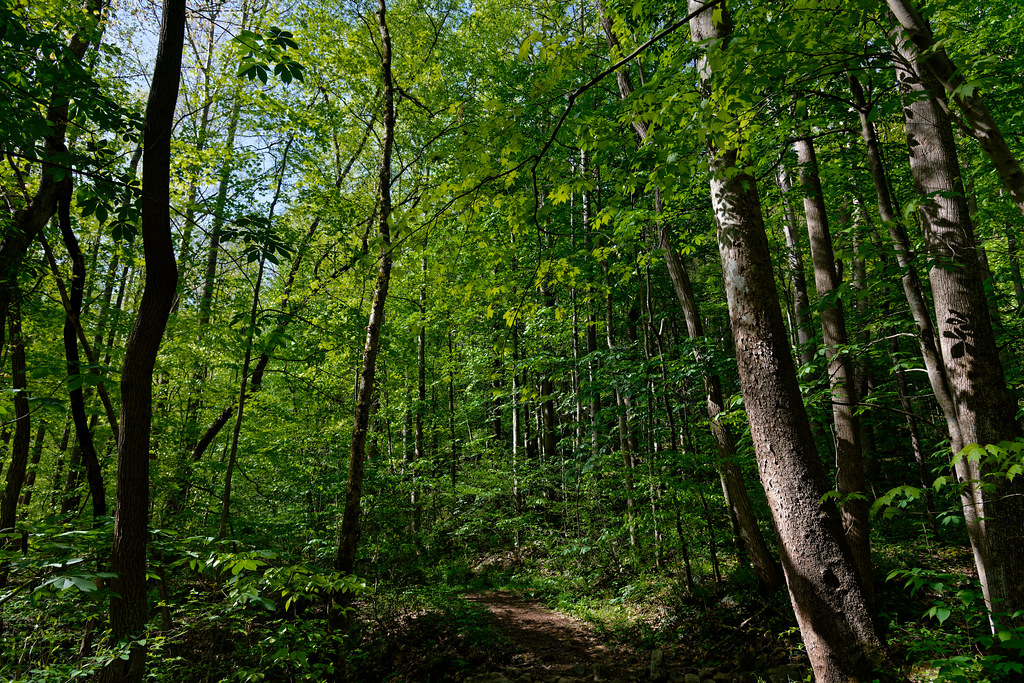#Southern Allegheny Mountains
Video
Leave Me! (New River Gorge National Park & Preserve) by Mark Stevens
Via Flickr:
Leave Me! To wander the forest By myself but not alone Never in a hurry But a destination in mind I have stumbled on rocks And walked through streams The sun shines a filtered green Through the tall trees above It's almost heaven in... Another work of short poetry or prose to complement the image captured one afternoon in New River Gorge National Park & Preserve while heading out to walk the Stone Cliff Trail. The view in this image captured is looking south, using the hiking trail as a leading line into the woods and forest. My thinking in composing this image was to have more of a wider angle view and let the feeling of woods all around be that surrounding feeling. I did though have to spend more time metering the image, finding that shutter speed that would allow me to not blow any of the highlights in the brighter areas above while still being able to pull the more shadowed areas in the lower portion of the forest. I later worked with control points in DxO PhotoLab 4 and then made some adjustments to bring out the contrast, saturation and brightness I wanted for the final image.
#Nikon D850#New River Gorge and Indiana Dunes National Parks#Trip to New River Gorge and Indiana Dunes National Parks#Azimuth 193.90#Looking South#Day 4#Stone Cliff#Stone Cliff Trail#Appalachian Mountains#Appalachian Plateaus#Allegheny Mountains#Southern Allegheny Mountains#DxO PhotoLab 4 Edited#SnapBridge#No People#Scenics - Nature#Landscape - Scenery#Blue Skies#Sunny#Landscape#Nature#Outside#Travel#Trees#Woodland#Forest#Forest Landscape#Hiking Trail#Nature Trail#Trail
0 notes
Text

Helper Pit
Empty hoppers head West back to the mines behind an EMD SD40-2 / SD40 combo.
They're passing the ready tracks filled with EMD's at Conrail's Allegheny Mountain helper base.
Back then (1988), locomotives were fueled, sanded, watered, etc. here between assignments.
By this time, the ex-Erie Lackawanna EMD SD45-2's that were popular with railfans were disappearing from the mountain.
Now SD40-2's in sets of two and four became the helper of choice.
Under Norfolk Southern, Cresson became obsolete and was shut down.
Cresson, Pennsylvania
July 1988
44 notes
·
View notes
Text
Growing up southern/appalachian is really crazy like my mom really didnt have indoor plumbing in like the 80s 😭 like some of my family members from the early to late 1900s just did not learn to write or read. My dads family was UMC in charleston west virginia and they sent the crazies in his family to Weston (trans allegheny lunatic asylum) but when ur poor mountain trash its just like. Grandmas running around naked in the garden again. My great aunts husband tried to shoot her but he missed and she beat him half to death with a cast iron skillet and everybody is an alcoholic
23 notes
·
View notes
Note
What is like to live in Arizona?
I’m not gonna lie the heat is ridiculous even though it’s a dry heat. But I absolutely despise snow, so being in Southern Arizona is a treat because we only get really cold for like a week or two in the winter and the rest of the winter is super mild.
The Sonoran Desert is SOOOO pretty. I feel like most people hear desert and think it’s dusty and brown and dead, and yeah it’s sometimes those things, but oh my god it’s so green too? Saguaro are just amazing and impressive with what they can withstand. The fact that so many plants survive in this weather is astounding.
Then there’s the mountains???? I spent a lot of my childhood in and around the Appalachian Mountains and Allegheny Mountains in Pennsylvania, but the mountains out here put them to shame. Like I can walk outside my house and see a different mountain range every direction I turn. It’s been two years but sometimes I walk out of a store at the right time in the evening when the sun is setting and it hits a mountain range just right and I’ll be like “oh my god this place is beautiful can you believe we live here?”
5 notes
·
View notes
Text
Becoming a Flatlander

(Definition from the Urban Dictionary.)
I left my home in suburban Maryland on a hot Saturday morning with my recent-graduate-from-high-school daughter and my freaked out dog. We had been “camping” for several days in a house with no furniture. The dog, who gets upset when he sees us packing any kind of bag, was not letting us out of his sight.
We were all sleep deprived and exhausted from the stress of cleaning and packing, but excited to make some changes.
We are moving to Vermont.
Yes. I did say “Vermont.”
I’ve been having this conversation a lot: “Vermont? Why? Don’t you want to go somewhere warm?”
No, actually. I’ve had enough “warm.” I get physically sick in the heat so summer in central Maryland has been getting harder and harder to tolerate. I want to go someplace with a temperate summer, even if that does mean shoveling a lot more snow in winter.
I like to visit a tropical beach as much an anyone (particularly in January), but the sand and the ocean has always made me feel a little nervous. It’s so big and it’s moving all the time. There’s nothing solid to hang on to. I like being in the mountains and among the trees. That is where my soul can calm itself.
Vermont has lovely mountains, all full of mossy rocks, bubbling brooks, and big green trees.
So I found a little town that reminds me a lot of the town I grew up in nestled in the Green Mountains, and put a bid on an old Victorian (nicely rehabbed) house. We are spending a couple of weeks with my mom outside of Cincinnati while the real estate mortgage and title machine grind slowly along. In a few days, I will pack up the car with the daughter and the dog (who is still freaked out, but did manage to relax a bit at Mom’s house). We’ll drive 10+ hours in a day, edging along Lake Erie, and across the Allegheny Plateau of New York State to southern Vermont.
I’ll sign away a significant portion of my future earnings for the next 30 years and we’ll be Flatlanders: In Vermont, but not of Vermont.
I can live with that designation. It suggests a state of “in-between.”
I’m changing a huge part of my life. It’s going to take some time to refocus and solidify into that whatever I will eventually become.
At this point in my life, “in-between” describes me perfectly.
2 notes
·
View notes
Text
Events 10.7 (before 1950)
3761 BC – The epoch reference date (start) of the modern Hebrew calendar.
1403 – Venetian–Genoese wars: The Genoese fleet under a French admiral is defeated by a Venetian fleet at the Battle of Modon.
1477 – Uppsala University is inaugurated after receiving its corporate rights from Pope Sixtus IV in February the same year.
1513 – War of the League of Cambrai: Spain defeats Venice.
1571 – The Battle of Lepanto is fought, and the Ottoman Navy suffers its first defeat.
1691 – The charter for the Province of Massachusetts Bay is issued.
1763 – King George III issues the Royal Proclamation of 1763, closing Indigenous lands in North America north and west of the Alleghenies to white settlements.
1777 – American Revolutionary War: The Americans defeat British forces under general John Burgoyne in the Second Battle of Saratoga, also known as the Battle of Bemis Heights, compelling Burgoyne's eventual surrender.
1780 – American Revolutionary War: American militia defeat royalist irregulars led by British major Patrick Ferguson at the Battle of Kings Mountain in South Carolina, often regarded as the turning point in the war's Southern theater.
1800 – French corsair Robert Surcouf, commander of the 18-gun ship La Confiance, captures the British 38-gun Kent.
1826 – The Granite Railway begins operations as the first chartered railway in the U.S.
1828 – Morea expedition: The city of Patras, Greece, is liberated by the French expeditionary force.
1840 – Willem II becomes King of the Netherlands.
1864 – American Civil War: A US Navy ship captures a Confederate raider in a Brazilian seaport.
1868 – Cornell University holds opening day ceremonies; initial student enrollment is 412, the highest at any American university to that date.
1870 – Franco-Prussian War: Léon Gambetta escapes the siege of Paris in a hot-air balloon.
1879 – Germany and Austria-Hungary sign the "Twofold Covenant" and create the Dual Alliance.
1912 – The Helsinki Stock Exchange sees its first transaction.
1913 – Ford Motor Company introduces the first moving vehicle assembly line.
1916 – Georgia Tech defeats Cumberland University 222–0 in the most lopsided college football game in American history.
1919 – KLM, the flag carrier of the Netherlands, is founded. It is the oldest airline still operating under its original name.
1924 – Andreas Michalakopoulos becomes prime minister of Greece for a short period of time.
1929 – Photius II becomes Ecumenical Patriarch of Constantinople.
1933 – Air France is inaugurated, after being formed by a merger of five French airlines.
1940 – World War II: The McCollum memo proposes bringing the United States into the war in Europe by provoking the Japanese to attack the United States.
1944 – World War II: During an uprising at Birkenau concentration camp, Jewish prisoners burn down Crematorium IV.
1949 – The communist German Democratic Republic (East Germany) is formed.
0 notes
Text
Beautiful Trails, A Lake And A Lot of History But No Wildlife At Ricketts Glen State Park
It’s been a year since I last visited Ricketts Glen State Park. This was too long. I need to visit this wonderful park more often. It is about 40 miles, and a one hour drive, from my home in Southern Luzerne County. It located atop the edge of the Allegheny Plateau in Luzerne, Colombia and Sullivan Counties. I could see the ridge and North Mountain on a clear day from a lookout near my…
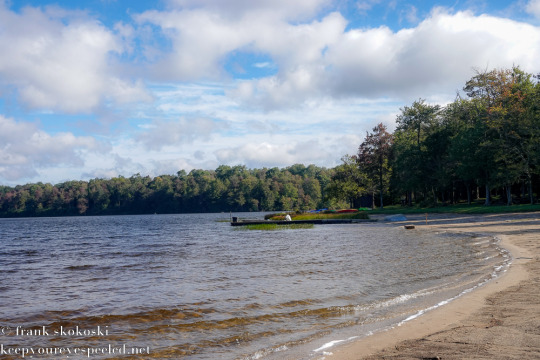
View On WordPress
0 notes
Photo

Day 7: Chesapeake & Ohio Allegheny
Info from Wikipedia:
The Chesapeake and Ohio H-8 was a class of 60 2-6-6-6 steam locomotives built by the Lima Locomotive Works in Lima, Ohio between 1941 and 1948 and operated until the mid 1950s. The locomotives were among the most powerful steam locomotives ever built and hauled fast and heavy freight trains for the railroad and two have been preserved, Nos. 1601 and 1604.
Built for hauling freight through the Allegheny Mountains, the locomotives were given the nickname "Alleghenies". Each H-8 cost around $230,000. They could operate an 11,500-ton coal train at up to 45 mph and up to 60 mph pulling passenger trains. They also had the heaviest axle load of any steam locomotive, with a maximum axle load of 86,700 lbs. Gene Huddleston's book, "C&O Power", reports tests of the C&O with a dynamometer car indicating momentary readings of 7,498 hp (5.6 MW) with readings between 6,700 to 6,900 hp (5.0 to 5.1 MW) at about 45 mph (72 km/h). No one has published a higher dynamometer horsepower for any steam locomotive. The locomotive was built to power coal trains on the 0.57% eastward climb from White Sulphur Springs, West Virginia to Alleghany, Virginia. With one at the front and another at the back, 11,500-ton coal trains left Hinton, WV and were at full throttle from White Sulphur Springs to the top of the grade at Alleghany. C&O's 2-6-6-6s also handled coal trains from West Virginia to Columbus, Ohio. Huddleston says that 23 locomotives were equipped with steam piping for heating passenger trains. Upon dieselisation, retirement started in 1952 and by 1956, all of the Alleghenies have been retired.
No. 1642 suffered a crown sheet failure and subsequent boiler explosion at Hinton, WV in June, 1953. The crew did not survive the blast.
Two Alleghenies have been preserved:
No. 1601 was retired in 1956 and donated to the Henry Ford Museum in Dearborn, Michigan where it has been on display indoors since.
No. 1604 was initially sent to C&O's scrap lines behind their diesel shops at Russell, Kentucky upon retirement. It was then donated to the Virginia Museum of Transportation in Roanoke in 1969 where it was displayed next to N&W 1218. On November 4th, 1985, it was partially damaged by a flood, which washed away the ground under it and nearly turned the locomotive over. In 1987, parent company Norfolk Southern did a cosmetic overhaul on it at their Roanoke Shops before it was sent to Baltimore to be displayed as the centerpiece of the then Mount Clare Junction shopping center which was adjacent to the B&O Railroad Museum. In 1989, the shopping center donated it to the museum, where it presently resides.
Models and Route by: Subpar Productions, Auran, and Download Station
#C&O#Chesapeake & Ohio#Chesapeake & Ohio Railway#Chesapeake & Ohio Railroad#Allegheny#C&O Allegheny#Chesapeake & Ohio Allegheny#Steam Locomotive#Trains#Trainz Simulator#Christmas#Advent Calendar#Christmas 2022 🎄🎅🎁
1 note
·
View note
Photo


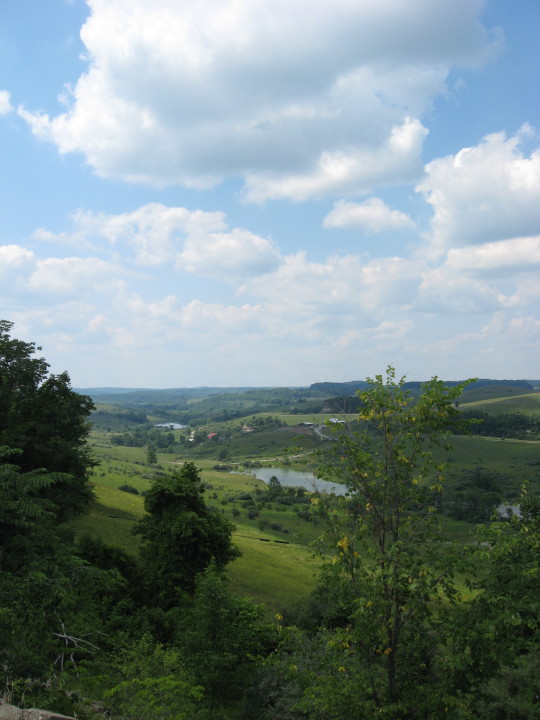
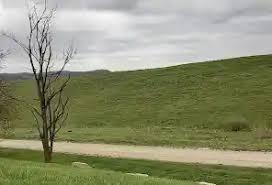
Egypt Valley Wildlife Area
State Route 800
Piedmont, OH 43983
Situated in the southeastern part of Ohio, the Egypt Valley Wildlife Area is a 14,300 acre former surface mining area in northwestern Belmont County and part of Guernsey County, Ohio, with the primary access by Interstate 70 and State Route 800. Morristown is located 3 miles east of the wildlife area. Hendrysburg is on the southern edges of the area, while Holloway and Flushing are on the northern edge of the area. The southern end of Piedmont Lake, the opposite end of the dam in Piedmont, juts into the northern pocket of the area as well.Since the mid-1990s, the Ohio Department of Natural Resources has administered the area. For many years, local residents have fished, hunted, camped and explored the high walls, backwaters, and graveyards that make up this area. People call the area Egypt Bottom.
Before the area became a sporting destination, it was surface-mined. Egypt Valley was home to some of the largest earth moving machines, most notably the GEM of Egypt, and the less known Mountaineer. The high walls and unique look to the area was the end-result of this mining method. Most coal extraction ceased in the early 1990s. Aside from the coal mining in the area, Egypt Valley is known for its rich tradition of local folklore. The Salem Cemetery, located in the middle of the area, is home to the grave of Louiza Fox, a thirteen-year-old girl who was murdered in 1869. Her murderer, Thomas Carr, 22 years old, was the first person hanged in Belmont County.
Egypt Valley Wildlife Area is located in the unglaciated region of southeastern Ohio in the low hills belt of the steep Allegheny Plateau. The terrain is steep to rolling and is dissected by numerous small streams. Elevations vary from 925 feet to 1,363 feet above sea level. Over the last 70 years, approximately 80 percent of the acreage that comprises Egypt Valley Wildlife Area has been subject to surface mining. The last active mine was completed in 1998. Today all of the forests consist of second and third growth timber. Much of the land that was cleared is now in grassland or brushland and dotted with many small ponds and wetlands. Because of the mining, large expanses of grassland and brushland habitats have been created.
Land acquisition for the Egypt Valley Wildlife Area began in 1995 with 14,300 acres being purchased from The Conservation Fund. Various groups, including Ducks Unlimited, The National Wild Turkey Federation, and the Ruffed Grouse Society, all partnered with the Division of Wildlife in the purchase and approximately 18,011 acres have been acquired to date. Piedmont Lake, a U.S. Army Corps of Engineers lake, managed by the Muskingum Watershed Conservancy District is located in the middle of the two land parcels that make up Egypt Valley Wildlife Area. Egypt Valley, a popular regional outdoor destination, offers many small, mainly isolated, strip pit ponds, creeks, and backwaters to explore, hunt, and fish.
Deer, turkey, waterfowl, squirrel, grouse, rabbit, and dove are common within the area. Many of the small ponds have been stocked with bass, catfish, and bluegills by the Division of Wildlife. Species not traditionally found in eastern Ohio such as the short-eared owl, Northern harrier, Henslow’s sparrow, and bobolink can be found on the large expanses of grassland. Bald eagles and ospreys occasionally stop on the wildlife area on their annual migration. River otters were reintroduced to this area in 1993 and now a thriving population can be found there.
Egypt Valley Wildlife Area is popular for hunting, fishing, and other forms of wildlife recreation. Deer, turkey, waterfowl, squirrel, grouse, rabbit, and dove are the most sought after species for hunting. Many of the small ponds have been stocked with bass, catfish, and bluegills by the division and offer good fishing opportunities. Hiking, bird watching, photography, and sightseeing are also popular on the wildlife area. Boating is allowed on nearby Piedmont Lake. Outboard motors may not exceed 10 horsepower.
0 notes
Text
We do have mountains but they’re smaller mountains -- not like the majestic mountains you see out west...widely spread from a distance. Ours are smaller versions of majestic mountains and nestled closer together and covered in an assortment of trees as far as the eyes can see. We live in the mountains, literally. We live among them and on them and around them and in their valleys and at their peaks and somewhere in the middle. We truly are hill people without the class of Beverly. So, ya know, instead of the mountain state, which is kind of a lie, it should be called the tree state because I’m willing to bet we have more trees than we do mini-mountains. For every mini-mountain, there’s a least a thousand trees covering it. So...yeah.
#mydeafears#home state#the Bible belt#Appalachia#Allegheny mountains#Appalachian mountains#east coast#southern#south#mason dixon
3 notes
·
View notes
Video
Sandstone Falls and the New River (New River National Park & Preserve) by Mark Stevens
Via Flickr:
Looking to the southwest across the waterfalls area and then to distant ridgelines with Chestnut Mountain of the Southern Allegheny Mountains. I decided on capturing a long exposure to create a silkier look to the waters. Given the recent rains and the amount of water flowing and the overcast skies, I realized I only had to close down on my Nikon SLR camera’s aperture for that capture. I later did a conversion to black & white using Silver Efex Pro 2 where I made some adjustments to color filters to bring out a much richer tonal contrast for the final image.
#Allegheny Mountains#Appalachian Mountains#Appalachian Plateaus#Azimuth 226#Black & White#Chestnut Mountain#Cloudy#Day 2#DxO PhotoLab 4 Edited#Fallen Trees#Fallen Trees in River#Falls#Forest#Forest Landscape#Hillside of Trees#Landscape#Landscape - Scenery#Looking SW#Mostly Cloudy#Mountains#Mountains in Distance#Mountains off in Distance#Mountainside#Nature#New River#New River Gorge National Park & Preserve#New River Gorge National Park and Preserve#New River Gorge and Indiana Dunes National Parks#Nikon D850#No People
2 notes
·
View notes
Text
William Wright, Abolitionist
WILLIAM WRIGHT
See p. 691.
MEMORIAL.
William Wright, a distinguished abolitionist of Adams county, Pennsylvania, was born on the 21st of December, 1788. Various circumstances conspired to make this unassuming Quaker an earnest Abolitionist and champion of the oppressed in every land and of every nationality and color. His uncle, Benjamin Wright, and cousin, Samuel B. Wright, were active members of the old Pennsylvania Abolition Society, and at the time of the emancipation of the slaves in this state were often engaged in lawsuits with slave-holders to compel them to release their bondmen, according to the requirements of the law. William Wright grew up under the influence of the teachings of these relatives. Joined to this, his location caused him to take an extraordinary interest in Underground Rail Road affairs. He lived near the foot of the southern slope of the South Mountain, a spur of the Alleghenies which extends, under various names, to Chattanooga, Tennessee. This mountain was followed in its course by hundreds of fugitives until they got into Pennsylvania, and were directed to William Wright's house.
In November, 1817, William Wright married Phebe Wierman, (born on the 8th of February, 1790,) daughter of a neighboring farmer, and sister of Hannah W. Gibbons, wife of Daniel Gibbons, a notice of whom appears elsewhere in this work. Phebe Wright was the assistant of her husband in every good work, and their married life of forty-eight years was a long period of united and efficient labor in the cause of humanity. She still (1871) survives him. William and Phebe Wright began their Underground Rail Road labors about the year 1819. Hamilton Moore, who ran away from Baltimore county, Maryland, was the first slave aided by them. His master came for him, but William Wright and Joel Wierman, Phebe Wright's brother, who lived in the neighborhood, rescued him and sent him to Canada.
In the autumn of 1828, as Phebe Wright, surrounded by her little children, came out upon her back porch in the performance of some household duty, she saw standing before her in the shade of the early November morning, a colored man without hat, shoes, or coat. He asked if Mr. Wright lived there, and upon receiving an affirmative reply, said that he wanted work. The good woman, comprehending the situation at a glance, told him to come into the house, get warm, and wait till her husband came home. He was shivering with cold and fright. When William Wright came home the fugitive told his story. He came from Hagerstown, Maryland, having been taught the blacksmith's trade there. In this business it was his duty to keep an account of all the work done by him, which record he showed to his master at the end of the week. Knowing no written character but the figure 5 he kept this account by means of a curious system of hieroglyphics in which straight marks meant horse shoes put on, circles, cart-wheels fixed, etc. One day in happening to see his master's book he noticed that wherever five and one were added the figure 6 was used. Having practiced this till he could make it he ever after used it in his accounts. As his master was looking over these one day, he noticed the new figure and compelled the slave to tell how he had learned it. He flew into a rage, and said, "I'll teach you how to be learning new figures," and picking up a horse-shoe threw it at him, but fortunately for the audacious chattel, missed his aim. Notwithstanding his ardent desire for liberty, the slave considered it his duty to remain in bondage until he was twenty-one years old in order to repay by his labor the trouble and expense which his master had had in rearing him. On the evening of his twenty-first anniversary he turned his face toward the North star, and started for a land of freedom. Arriving at Reisterstown, a village on the Westminster turnpike about twenty-five miles from Baltimore and thirty-five miles from Mr. Wright's house, he was arrested and placed in the bar-room of the country tavern in care of the landlady to wait until his captors, having finished some work in which they were engaged, could take him back to his master. The landlady, being engaged in getting supper, set him to watch the cakes that were baking. As she was passing back and forth he ostentatiously removed his hat, coat, and shoes, and placed them in the bar-room. Having done this, he said to her, "I will step out a moment." This he did, she sending a boy to watch him. When the boy came out he appeared to be very sick and called hastily for water. The boy ran in to get it. Now was his golden opportunity. Jumping the fence he ran to a clump of trees which occupied low ground behind the house and concealing himself in it for a moment, ran and continued to run, he knew not whither, until he found himself at the toll gate near Petersburg, in Adams county. Before this he had kept in the fields and forests, but now found himself compelled to come out upon the road. The toll-gate keeper, seeing at once that he was a fugitive, said to him, "I guess you don't know the road." "I guess I can find it myself," was the reply. "Let me show you," said the man. "You may if you please," replied the fugitive. Taking him out behind his dwelling, he pointed across the fields to a new brick farm-house, and said, "Go there and inquire for Mr. Wright." The slave thanked him and did as he was directed.
He remained with William Wright until April, 1829. During this short time he learned to read, write, and cipher as far as the single rule of three, as it was then called, or simple proportion. During his residence with William Wright, nothing could exceed his kindness or gratitude to the whole family. He learned to graft trees, and thus rendered great assistance to William Wright in his necessary business. When working in the kitchen during the winter he would never allow Phebe Wright to perform any hard labor, always scrubbing the floor and lifting heavy burdens for her. Before he went away in the spring he assumed a name which his talents, perseverance, and genius have rendered famous in both hemispheres, that of James W.C. Pennington. The initial W. was for his benefactor's family, and C. for the family of his former master. From William Wright's he went to Daniel Gibbons', thence to Delaware county, Pennsylvania, and from there to New Haven, Conn., where, while performing the duties of janitor at Yale College, he completed the studies of the college course. After a few years, he went to Heidelberg, where the degree of D.D. was conferred upon him. He never forgot William Wright and his family, and on his return from Europe brought them each a present. The story of his escape and wonderful abilities was spread over England. An American acquaintance of the Wright family was astonished, on visiting an Anti-slavery fair in London many years ago, to see among the pictures for sale there, one entitled, "William and Phebe Wright receiving James W.C. Pennington." The Dr. died in Florida, in 1870, where he had gone to preach and assist in opening schools amongst the Freemen.
In 1842 a party of sixteen slaves came to York, Pa., from Baltimore county, Md. Here they were taken in charge by William Wright, Joel Fisher, Dr. Lewis, and William Yocum. The last named was a constable, and used to assist the Underground Rail Road managers by pretending to hunt fugitives with the kidnappers. Knowing where the fugitives were he was enabled to hunt them in the opposite direction from that in which they had gone, and thus give them time to escape. This constable and a colored man of York took this party one by one out into Samuel Willis' corn-field, near York, and hid them under the shocks. The following night Dr. Lewis piloted them to near his house, at Lewisburg, York county, on the banks of the Conewago. Here they were concealed several days, Dr. Lewis carrying provisions to them in his saddle-bags. When the search for them had been given up in William Wright's neighborhood, he went down to Lewisburg and in company with Dr. Lewis took the whole sixteen across the Conewago, they fording the river and carrying the fugitives across on their horses. It was a gloomy night in November. Every few moments clouds floated across the moon, alternately lighting up and shading the river, which, swelled by autumn rains, ran a flood. William Wright and Dr. Lewis mounted men or women behind and took children in their arms. When the last one got over, the doctor, who professed to be an atheist, exclaimed, "Great God! is this a Christian land, and are Christians thus forced to flee for their liberty?" William Wright guided this party to his house that night and concealed them in a neighboring forest until it was safe for them to proceed on their way to Canada.
Just in the beginning of harvest of the year 1851, four men came off from Washington county, Maryland. They were almost naked and seemed to have come through great difficulties, their clothing being almost entirely torn off. As soon as they came, William Wright went to the store and got four pair of shoes. It was soon heard that their masters and the officers had gone to Harrisburg to hunt them. Two of them, Fenton and Tom, were concealed at William Wright's, and the other two, Sam and one whose name has been forgotten, at Joel Wierman's. In a day or two, as William Wright, a number of carpenters, and other workmen, among whom were Fenton and Tom, were at work in the barn, a party of men rode up and recognized the colored men as slaves of one of their number. The colored men said they had left their coats at the house. William Wright looked earnestly at them and told them to go to the house and get their coats. They went off, and one of them was observed by one of the family to take his coat hastily down from where it hung in one of the outhouses, a few moments afterward. After conversing a few moments at the barn, William Wright brought the slave-holders down to the house, where he, his wife and daughters engaged them in a controversy on the subject of slavery which lasted about an hour. One of them seemed very much impressed, and labored hard to convince his host that he was a good master and would treat his men well. Finally one of the party asked William Wright to produce the men. He replied that he would not do that, that they might search his premises if they wished to, but they could not compel him to bring forth the fugitives. Seeing that they had been duped, they became very angry and proceeded forthwith to search the house and all the outhouses immediately around it, without, however, finding those whom they sought. As they left the house and went toward the barn, William Wright, waving his hand toward the former, said, "You see they are not anywhere there." They then went to the barn and gave it a thorough search. Between it and the house, a little away from the path, but in plain sight, stood the carriage-house, which they passed by without seeming to notice. After they had gone, poor Tom was found in this very house, curled up under the seats of the old-fashioned family carriage. He had never come to the house at all, but had heard the voices of his hunters from his hiding-place, during their whole search. About two o'clock in the morning, Fenton was found by William Wright out in the field. He had run along the bed of a small water course, dry at that time of year, until he came to a rye field amid whose high grain he hid himself until he thought the danger was past. From William Wright's the slave-catchers went to Joel Wierman's, where, despite all that could be done, they got poor Sam, took him off to Maryland and sold him to the traders to be taken far south.
In 1856 William Wright was a delegate from Adams county to the Convention at Philadelphia which nominated John C. Fremont for President of the United States. As the counties were called in alphabetical order, he responded first among the Pennsylvania delegation. It is thought that he helped away during his whole life, nearly one thousand slaves. During his latter years, he was aided in the good work by his children, who never hesitated to sacrifice their own pleasure in order to help away fugitives.
His convictions on the subject of slavery seem to have been born with him, to have grown with his growth, and strengthened with his strength. He could not remember when he first became interested in the subject.
William Wright closed his long and useful life on the 25th of October, 1865. More fortunate than his co-laborer, Daniel Gibbons, he lived to see the triumph of the cause in which he had labored all his life. His latter years were cheered by the remembrance of his good deeds in the cause of human freedom. Modest and retiring, he would not desire, as he does not need, a eulogy. His labors speak for themselves, and are such as are recorded upon the Lamb's Book of Life.
####################################################
Album of pix of Plainfield w interior> https://goo.gl/photos/UKfYAyysNzACjBVF9
##########################################
The Wright House is located on property owned by Ludwigs on the northernmost end of Adams County in Latimore Township. It's along Latimore Valley Road, set back in a bit. I have never seen it in person, so I don't know what condition it is currently in. It is on private property, which is why I do not give the location of the house on my website. The black and white photos are from the 1920s and the color photos are from 1993. It played a part in the underground railroad and at least one of the photos shows where slaves would have hidden. My Dad said he was back there when he was little and they pulled the dresser away to reveal the crawl space behind it. I think William and Phebe Wright were the ones who owned it, hence the name, the "Wright House." I don't know anything about them, though, off-hand. The house looks like it would have been a nice place if it had been fixed up, but I imagine it's beyond repair at this point.
-from email from D. Worley
2 notes
·
View notes
Photo










Tuscorora Summit, PA
Pennsylvania is bisected in an S-curve (or roughly diagonally) by the barrier ridges of the Appalachian Mountains from southwest to northeast, forcing pretwentieth century ground travel most often on or near the ancient Amerindian trails along the higher terrains of the local watersheds with limited penetration and connectivity often only through water gaps. As rough looking as the first map appears, the valley bottoms throughout the entire central part of the state and parts of lower New York state are connected by the Susquehanna River and its tributaries—virtually the whole length of which was improved into the Pennsylvania Canal System in the 1830s. To the northwest of the folded mountains is the Allegheny Plateau which lies above the cliff-like Allegheny Front escarpment, which continues into southwestern and south central New York, and is pierced in only a few places known as the gaps of the Allegheny.
This Allegheny Plateau is so dissected by valleys formed by small streams and springs that it also seems mountainous, but with elevation differences between valley floors and hilltop peaks most often less than a few hundred feet. The plateau is underlain by sedimentary rocks of Mississippian and Pennsylvanian age, which bear abundant fossils, mineral deposits such as iron, as well as natural gas, coal and petroleum. These regions fostered 17th-19th century industries locally even into the 1930s days of mass production. To the south and east of the escarpment/plateau region, the folded mountains and alternating valleys are known as the Ridge-and-Valley Appalachians. These extend from the South of the Appalachians to northern New England save where cut by water gaps. In Northeastern Pennsylvania from the east of Harrisburg on the Susquehanna River, these ridge and valley features contain the richest and most widespread deposits of high energy clean burning anthracite coal in the world—the Coal Region—without which the industrial revolution in the United States would have been severely retarded and delayed.
In 1859, near Titusville, Edwin L. Drake drilled the first oil well in the U.S. into these sediments.[2] Similar rock layers also contain coal to the south and east of the oil and gas deposits. In the metamorphic (folded) belt, anthracite (hard coal) is mined near Wilkes-Barre and Hazelton. These fossil fuels have been an important resource to Pennsylvania. Timber and dairy farming are also sources of livelihood for midstate and western Pennsylvania. Along the shore of Lake Erie in the far northwest are orchards and vineyards.
During the most recent Ice Age, the northeastern and northwestern corners of present-day Pennsylvania were buried under the southern fringes of the Laurentide Ice Sheet. Glaciers extended into the Appalachian valleys of central Pennsylvania, but the ice did not over top the mountains. At its furthest extent it spread as far south as Moraine State Park, about 40 miles (64 km) north of Pittsburgh.
Source: Wikipedia
#Mcconnellsburg#common burdock#Tuscorora Summit#Pennsylvania#USA#Appalachian Mountains#flora#view#fauna#nature#original photography#summer 2019#landscape#countryside#highway#vacation#travel#small town#vista point#Lincoln Highway#road trip
3 notes
·
View notes
Video
WM 75 - Raisin Twp, Michigan by Tyler Pate
Via Flickr:
Formally known at the LS&MS, today Southern Michigan Railroad Society a small tourist railroad that has about 20 miles of track own and operate on the first railroad west of the Allegheny Mountains. Unfortunately on this day the batteries went dead on the Western Maryland No.75 a GE 75 Ton center cab locomotive while the crew was out doing some brush cutting along the right of way. This railroad is known for their Fall Color tours during the fall peak in southeastern Michigan.
19 notes
·
View notes
Text
Decades of Tree Data Reveal Forests Under Attack
https://sciencespies.com/nature/decades-of-tree-data-reveal-forests-under-attack/
Decades of Tree Data Reveal Forests Under Attack

The Blue Ridge Mountains make up one of the oldest mountain ranges in the world. They are also home to forests with diverse tree populations. But those trees are under attack from invasive species, and Smithsonian researchers say that the impact over time is becoming ever more concerning.
According to a study published in the journal Ecosystems on April 29, in a section of the Blue Ridge Mountains, about a quarter of the loss of tree biomass—roughly one-quarter of tree death—over the past three decades was linked to invasive species transported by humans. The study is believed to be the first long-term look at the impact of multiple invasive species on aspects of the forest, the researchers reported.
One of the forest sections they studied is part of the Smithsonian’s Forest Global Earth Observatory, or ForestGEO, a network of sites that monitors changes to forests. The initiative dates to 1980, when Smithsonian researchers began mapping, measuring and tagging trees at a site in Panama. That original plot contained a quarter of a million trees. “No one had ever tried anything like this ever before,” says Stuart Davies, director of ForestGEO.

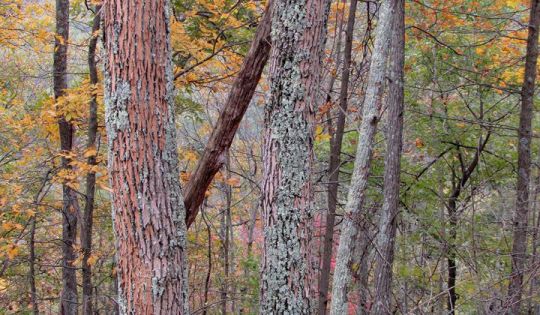


The researchers discovered ash trees infested with emerald ash borer beetles, which get under the bark and disrupt the tissue that brings water and dissolved minerals from the roots to the leaves.
(Alan Tepley, Smithsonian Conservation Biology Institute)
The network now monitors some six million trees inside tropical and temperate forests at 70 sites in 27 countries. The methodology to monitor them is consistent across sites, which makes the program unique. “Unless you measure things in the same way, it’s very hard to compare them,” Davies says. “What we have is a very clearly standardized protocol, where we know if you compare a data set from Gabon with a data set from Brazil, there’s no question.” More than a thousand research articles have come out of the network.
For the new study, the researchers focused on plots inside Shenandoah National Park in Virginia, which contains a section of the Blue Ridge Mountains, and a nearby plot monitored by the Smithsonian Conservation Biology Institute. The team from the Smithsonian and the park looked at 67 plots of forest across 73 acres. The data was from 1987 to 2019 and contained more than 350,000 tree observations.
“We know that pests and pathogens can have a really important impact. But it’s highly variable in time and space,” says Kristina Anderson-Teixeira, a forest ecologist at SCBI and the Smithsonian Tropical Research Institute and lead author of the study. “I wanted to get a broader overall picture of, long-term, how have these been affecting the forests as a whole?”
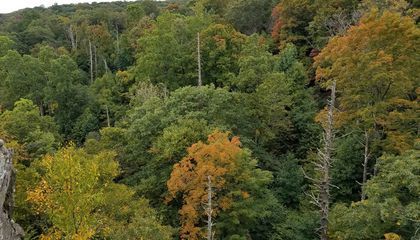
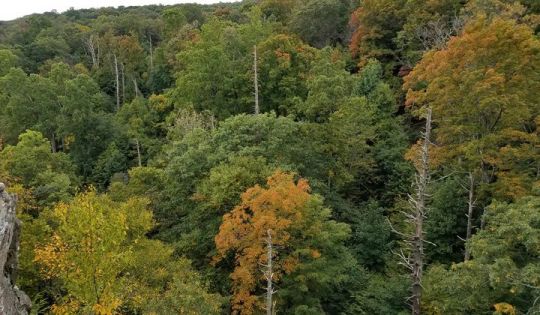
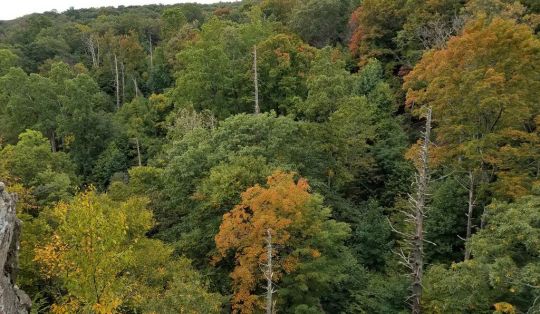

“People need to appreciate forests, recognize that our water, our clean air, so many services that we depend on, are the result of fully functioning, healthy forests,” says Stuart Davies, director of ForestGeo.
(Alan Tepley, Smithsonian Conservation Biology Institute)
The researchers found that the invasive species were tied to around 25 percent of tree deaths over the time period studied. “That’s pretty significant for the functioning of the forest,” Anderson-Teixeira says. “We’re losing cool species, species that we value for one reason or the other.” Normally trees have mortality rates of 1 or 2 percent per year, she says. For the trees that invasive species impacted, the figure was as high as 20 percent.
Changes to the forest affect the animals that live in them. This area is known for bobcats, raccoons, eastern striped skunks and opossums. “There are these cascading impacts of the forest composition on. . . the forest animals,” Anderson-Teixeira says. For example, the gypsy moth, an invasive insect, has devastated oak tree populations in the area, and animals such as American black bears, white-tailed deer, Allegheny woodrats, Eastern gray squirrels, and southern flying squirrels rely on acorns from those trees.
“Due to these invasive species,” says William McShea, a wildlife ecologist with the Conservation Ecology Center at SCBI and one of the study’s 20 authors, “you’re getting a lot more young trees, and that’s a much different forest composition. That benefits some species and doesn’t benefit others.” White-tailed deer flourish with young vegetation and woody plants at the forest floor, for example. But other species, including birds, prefer a more mature forest, according to McShea.
Invasive species aren’t just a problem in the Blue Ridge Mountains; they impact forests throughout the United States. People have documented at least 471 exotic insects and pathogens in forests across the country over the past few centuries, and similar situations exist in Europe and Asia.
The problem is species-specific, so particular invasive species impact particular tree hosts. The researchers identified eight combinations of invasive pests or pathogens and their hosts: American chestnuts suffered from chestnut blight, a fungus from Asia; elms had Dutch elm disease, also a fungus from Asia; redbuds had neofusioccum, a fungus of unknown origin; butternut trees had butternut canker, another fungus from Asia; dogwoods had dogwood anthracnose, yet another fungus from Asia; oaks attracted the gypsy moth, an insect from Europe; hemlocks were victim to hemlock woolly adelgid, an insect from Asia; and ash trees attracted the emerald ash borer, another insect from Asia.
Of the eight tree taxa they studied, seven have species that are now threatened or endangered because of the invasive pests or pathogens, according to the study. The researchers found six more combinations, but those trees declined possibly due to other factors.
Invasive species impact the trees through different means. For example, the emerald ash borer, an insect, gets under the bark and disrupts the xylem, a tissue that brings water and dissolved minerals from the roots to the leaves. Gypsy moths cause leaves to fall off trees.
Because of global trade and travel, invasive species will likely remain a problem. Climate change can make the problem worse, because unhealthy forests are less resistant to exotic species, and those pests and pathogens can spread faster under warmer conditions, according to Anderson-Teixeira.
Invasive species are among several ways that forests are under attack. Forest fires, such as those that burned in the Amazon rainforest in 2019 due to human deforestation, climate change and drought are additional ways. Even native species, such as white-tailed deer, which are in high density in certain parts of Shenandoah National Park, can disrupt the balance of the ecosystem if not regulated. As Anderson-Teixeira puts it, “There’s a lot of pressures on forests these days.”
These threats are evolving. Changes to land use are becoming increasingly worrisome to the forest monitors at ForestGEO. “We’re still losing something between 80 and 100,000 square kilometers of tropical rainforest every year,” says Davies, the ForestGEO director. This deforestation and fragmentation of forests allows other threats to increase, according to Davies. For example, hunting often happens when forests are more accessible to humans; fragmented forests are likely more susceptible to climate fluctuations; and when animals do not stay isolated in their forest habitats, they can transmit pathogens to humans, including coronaviruses.
But the researchers found that overall, the forest they studied remained healthy, even as trees impacted by invasive species died. That’s because forests are resilient.
The average above-ground biomass, a measure of trees above the soil, actually increased, as trees that were impacted less by the invasive pests and pathogens grew. Tree biodiversity also did not change much. “In some patches,” Anderson-Teixeira says, “you’d look around and see more species than you would have in the past. It works because it’s a fairly diverse forest, so you’re losing some species, and less affected species are filling in.”
The study suggests that people and governments prevent invasive species through policy regulations, biosecurity and conservation to make forests more resilient.
“People need to appreciate forests, recognize that our water, our clean air, so many services that we depend on, are the result of fully functioning, healthy forests,” Davies says. “Many people who are stuck at home at the moment are probably starting to realize, ‘Heck, I didn’t realize how much I really appreciate being outside and walking in the park.”
#Nature
2 notes
·
View notes
Photo
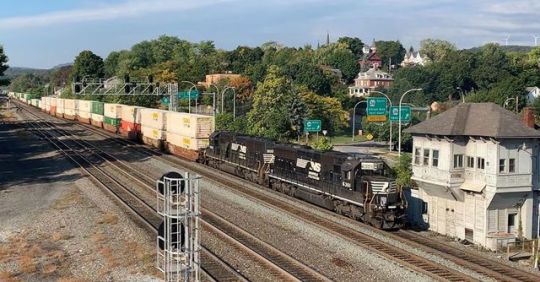
Norfolk Southern operates an extensive intermodal network and offers direct accessibility to containers, equipment, and #logistics solutions to ensure your goods are shipped from origin to destination safely, reliably, and efficiently. Learn more about shipping with NS: www.norfolksouthern.com Pictured: The leaves in the Alleghenies are beginning to show signs of autumn as a set of SD40E helper units assist train 25V up the mountain away from Altoona, Pennsylvania, passing the old Alto Tower. 25V moves intermodal equipment from the ERail terminal in Elizabeth, New Jersey, to the Landers Intermodal Terminal in Chicago. #transportation https://www.instagram.com/p/B3H1vVnHbYx/?igshid=12731yujbdvdq
11 notes
·
View notes
